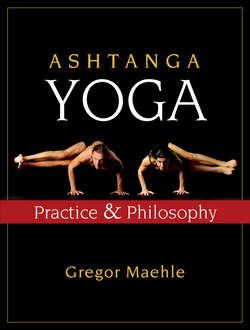Читать книгу Ashtanga Yoga - Gregor Maehle - Страница 44
На сайте Литреса книга снята с продажи.
Оглавление
Surya Namaskara A, vinyasa five (Upward Facing Dog)
Rather than rolling the shoulders back (which pinches the shoulder blades together by contracting the rhomboid muscles and leads to a closing behind the heart), keep the shoulder blades wide (serratus anterior muscle) and draw them down the back (latissimus dorsi). Rolling the shoulders back will free up the chest to move forward and puff out proudly like that of a lion. Imagine the arms as the upright support of a swing, the shoulder joints as the fulcrum, and the chest as the seat of the swing. Slide the heart through the arms to gain length in the spine. The lowest ribs now move forward and lift upward.
Lifting the chin to the ceiling and keeping the back of the neck long, the head is taken back. Those with previous whiplash injuries should avoid this movement and keep the neck straight, gazing down toward the tip of the nose; this will prevent overcontraction of the back of the neck. Students who are in need of inducing more backbend can look up between the eyebrows. At the same time be careful not to limit the backbend to the neck only.
This posture is frequently confused with Bhujangasana (Cobra) from Hatha Yoga, and often hybrids between the two postures can be observed. Upward Facing Dog is distinctly different. As well as the arms being straight, the legs are kept strong and straight, so much so that the knees remain off the floor. The strength in the legs provides support for the lumbar spine. By keeping the legs straight, the stretch is taken in the front of the hip joint, lengthening the hip flexor muscles, which is imperative in all backbending postures. It is important to draw forward with the arms and lengthen the whole spine, rather than to collapse and dip into the low back. Incorrectly performed, this posture can easily lead to low-back pain. Performed correctly, it can relieve back pain caused by spending long hours sitting at a desk or in a driver’s seat.
ANATOMICAL FOCUS
Spinal Junctions
The place where the spine meets the head (the cranium) is one of the important junctions of the spine. The others are the last cervical vertebra (C7) and the first thoracic vertebra (T1); the last thoracic vertebra (T12) and first lumbar vertebra (L1); and where the last lumbar vertebra (L5) articulates with the sacrum (S1-5). Laterally, the sacrum articulates with the pelvis, the sacroiliac (SI) joints. These are all areas where the spine encounters greater stresses. These areas have muscle attachments that work in opposing directions to equip us with a greater range of movement possibilities. It is therefore important to work these areas with awareness and respect in regard to their structural limitations and their vulnerability.
At the same time, the rectus abdominis muscle (the six-pack muscle) must be engaged to anchor the lower ribs and prevent them flaring open. Flaring the lower ribs accentuates swaying of the low back. The rectus abdominis will also lift the pubic bone and allow the coccyx to drop. This will enable one to carry the spine long and tall in all postures.
Urdhva Mukha Shvanasana is an extremely important posture in the sequence, as it is the only real preparation for backbending in the Primary Series. It should be deeply experienced every time it occurs in the series to awaken the spine for backbending. Take your time, with long, conscious inhalations rather than a short breath, moving quickly into and out of this posture.
